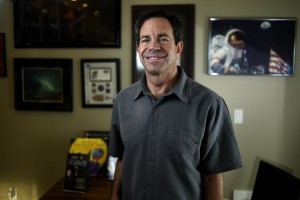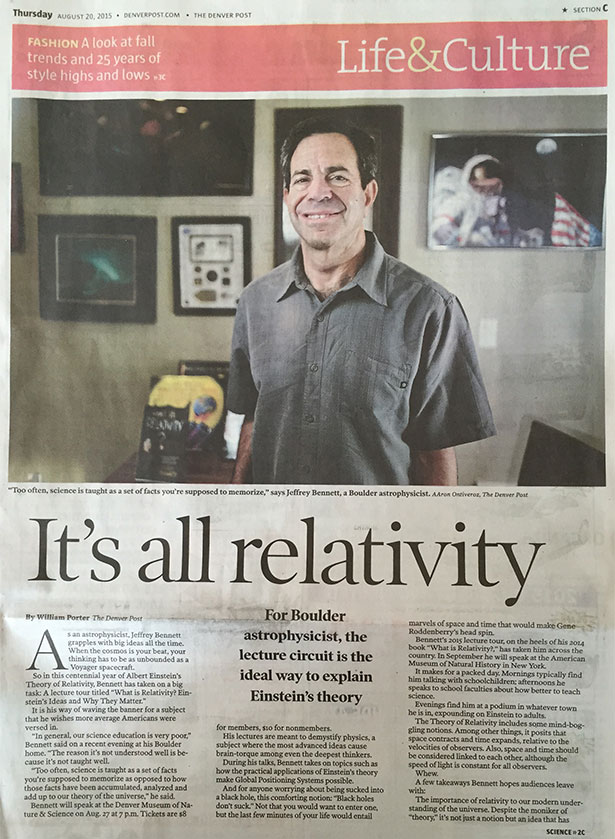Published in the Denver Post
As an astrophysicist, Jeffrey Bennett grapples with big ideas all the time. When the cosmos is your beat, your thinking has to be as unbounded as a Voyager spacecraft.
So in this centennial year of Albert Einstein’s Theory of Relativity, Bennett has taken on a big task: A lecture tour titled “What is Relativity? Einstein’s Ideas and Why They Matter.”
It is his way of waving the banner for a subject that he wishes more average Americans were versed in.

“Too often, science is taught as a set of facts you’re supposed to memorize,” says Jeffrey Bennett, a Boulder astrophysicist. (AAron Ontiveroz, The Denver Post)
“In general, our science education is very poor,” Bennett said on a recent evening at his Boulder home. “The reason it’s not understood well is because it’s not taught well.
(Handout)
“Too often, science is taught as a set of facts you’re supposed to memorize as opposed to how those facts have been accumulated, analyzed and add up to our theory of the universe,” he said.
Bennett will speak at the Denver Museum of Nature & Science on Aug. 27 at 7 p.m. Tickets are $8 for members, $10 for nonmembers.
His lectures are meant to demystify physics, a subject where the most advanced ideas cause brain-torque among even the deepest thinkers.
During his talks, Bennett takes on topics such as how the practical applications of Einstein’s theory make Global Positioning Systems possible.
And for anyone worrying about being sucked into a black hole, this comforting notion: “Black holes don’t suck.” Not that you would want to enter one, but the last few minutes of your life would entail marvels of space and time that would make Gene Roddenberry’s head spin.
Bennett’s 2015 lecture tour, on the heels of his 2014 book “What is Relativity?,” has taken him across the country. In September he will speak at the American Museum of Natural History in New York.
It makes for a packed day. Mornings typically find him talking with schoolchildren; afternoons he speaks to school faculties about how better to teach science.
Evenings find him at a podium in whatever town he is in, expounding on Einstein to adults.
The Theory of Relativity includes some mind-boggling notions. Among other things, it posits that space contracts and time expands, relative to the velocities of observers. Also, space and time should be considered linked to each other, although the speed of light is constant for all observers.
Whew.
A few takeaways Bennett hopes audiences leave with:
The importance of relativity to our modern understanding of the universe. Despite the moniker of “theory,” it’s not just a notion but an idea that has stood up to rigorous testing.
Einstein’s achievement and ability to articulate his ideas speak to the potential of the human imagination. “I think this is why Einstein was such an optimist about the human race even though he lived in some of the most difficult times in human history.”
Despite his criticism of general science education, Bennett is a champion of American scientists. They are trained superbly; it’s science education for non-scientists that he faults.
“Americans are very interested in science, and given the opportunity to learn it they learn it quite well. We just need to do a better job in our schools.”
Bennett is encouraged by the adoption of a Common Core science curriculum called Next Generation Science Standards.
“But the difficulty with all these things is that the single most forgotten thing in education is that learning requires study and effort,” he said. “So they give teachers these new and better standards but no more time and support to teach them.”
Asked when he was bitten by the science bug, Bennett pointed to the east wall of his spacious, second-floor office.
On the wall was a framed image of the July 21, 1969, edition of The New York Times. The bold, all-caps headline: “MEN WALK ON MOON.” And underneath: “ASTRONAUTS LAND ON PLAIN; COLLECT ROCKS, PLANT FLAG.”
One small step for a man, one giant leap for mankind — and for the imagination of a 10-year-old kid in Southern California.
“Early on, I thought I was going to be an engineer,” Bennett said. “But I took a physics course in my freshman year of college (University of California-San Diego, in his hometown) and knew that would be my career.”
Bennett went on to earn a doctorate at the University of Colorado at Boulder. He lives on the city’s western edge, in the shadow of Mount Sanitas. His home is a handsome two-story that he shares with his wife, two teenage children, and a big, friendly Rottweiler named Otis.
A Rottweiler just happens to be the star of Bennett’s “Max” series of children’s books, which include “Max Goes to the Moon” and “Max Goes to Jupiter,” among others.
He has written five books for adults and six textbooks. A former teacher at CU, he is president of Big Kid Science and remains affiliated with CU’s Fiske Planetarium.
There’s one other notion that intrigues Bennett, and it is one where physics meets philosophy.
It is the idea that at the most extreme reaches of space-time theory, every action a person ever makes — each moment in someone’s life — could conceivably be accessed by a four-dimensional being.
“It’s kind of like your school threatening you with your ‘permanent record,’ ” Bennett said. “I think if we grasped that we’d treat each other a little better because you’d be worried about leaving that mark.”
William Porter: 303-954-1877, wporter@denverpost.com or twitter.com/williamporterdp

